A Tribute To Renaissance Man Stephen Alling Halsey The Story Behind Stephen A. Halsey JHS 157 & The Halsey House Building Community For Generations
Views: 545
by Michael Perlman
The historical communities of Forest Hills and Rego Park offer a trail of sites that convey a distinctive ambiance and tell a story, which become subject to our own story and interpretation based on architectural design and memories. Frequented daily is a noble school, Stephen A. Halsey J.H.S. 157 (1947 – 1948) at 63-55 102nd Street, as well as a stately apartment building, The Halsey House (1948) at 63-33 98th Place, but one must wonder what is behind their names.
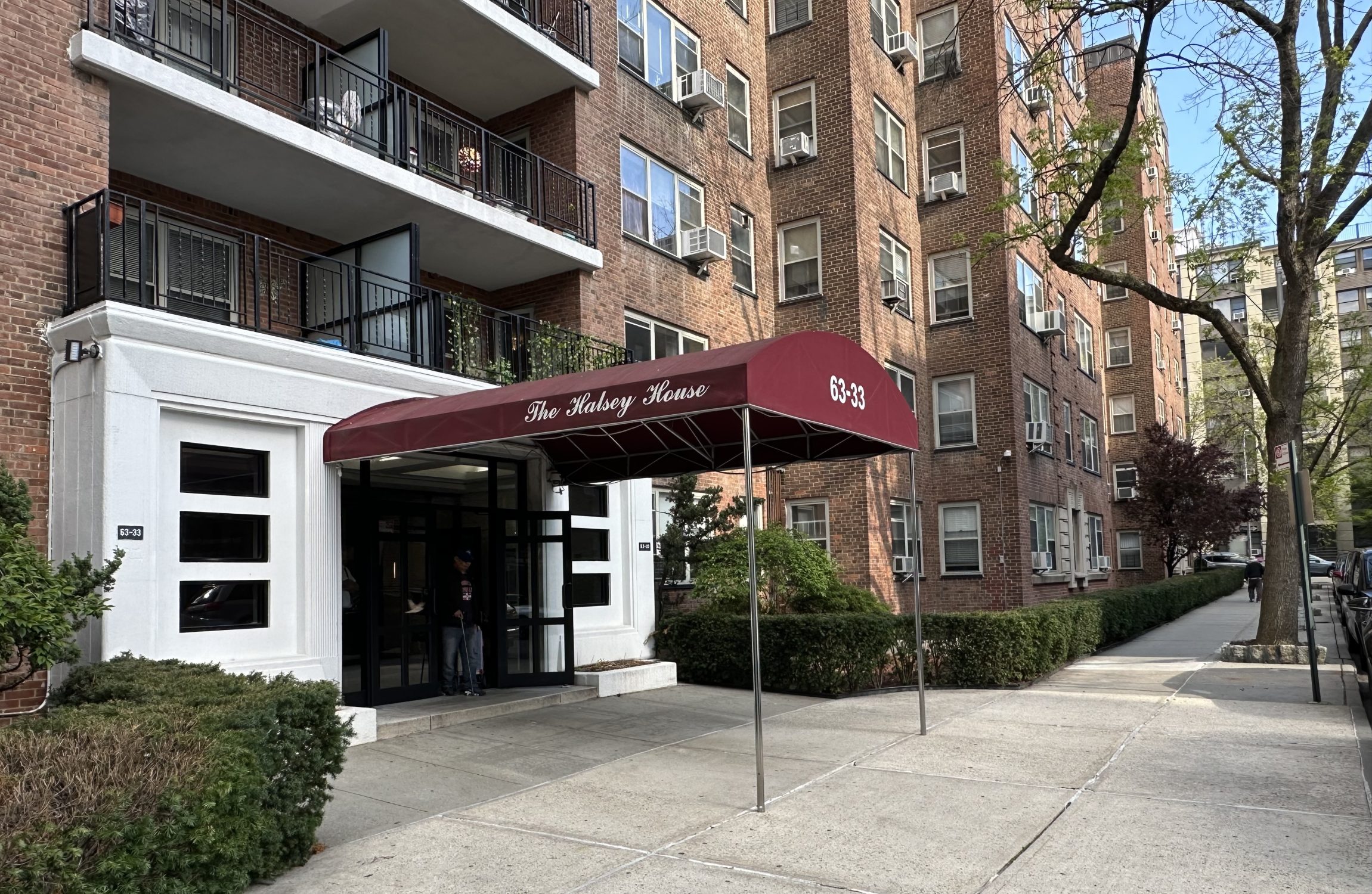
The Halsey House moderne entrance & facade, photo by Michael Perlman
The historic school features a stone colonnade front entrance, where “Stephen A. Halsey Junior High School” is prominently etched across the top, complemented by two floral roundels. Nearby is a 1947 cornerstone. The brick school was designed in a modified Colonial style featuring Greek motifs, urns, and glass block. Student-based gardens surround the property, and a recreation area is adjacent. The 1939 – 1940 World’s Fair occurred not long prior, which was partially responsible for a local population and development boom, consisting of nearby Colonial and Tudor rowhouses, as well as six-story garden apartment buildings.
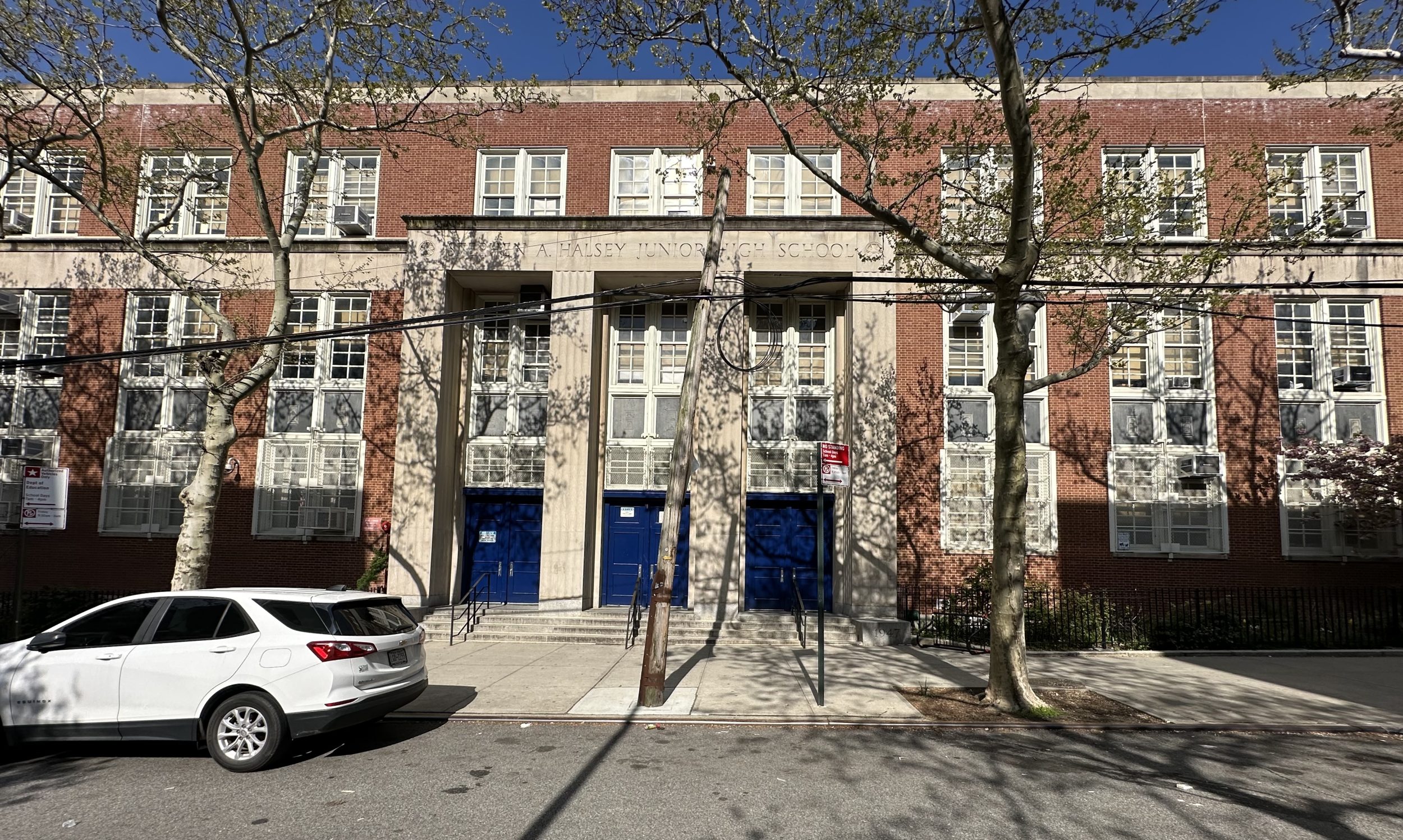
Stephen A. Halsey JHS 157 colonnade bearing an inscription, photo by Michael Perlman
Undeniably, Stephen Alling Halsey (1798 – 1875) was a visionary and high achiever, who played an influential role in Queens’ early development. He purchased the Blackwell and Perrot farms, situated between Pot Cove and Hallett’s Cove. His achievements include configuring streets and erecting wharves, houses, and factories, which attracted tradesmen and manufacturers. Under his leadership, this settlement became a village known as Astoria, officially in 1839.

Stephen Ailing Halsey, photo courtesy of Greater Astoria Historical Society
“Mayor O’Dwyer will break ground tomorrow for Junior High School 157 in the Forest Hills North section of Queens, it was announced yesterday at the Board of Education,” read a newsbrief in The New York Times on March 13, 1947. “Named for Stephen A. Halsey, who contributed to the early development of the borough, the school will be constructed at 102d Street between Sixty-Third Drive and Sixty-Fourth Avenue. The groundbreaking ceremonies are scheduled to begin at 1:30 P.M.”
The special day began with rain, symbolic of good fortune. Ceremonies opened in Forest Hills High School’s auditorium, where Deputy Mayor John J. Bennett actually delivered an address. Other testimonies were presented by Board of Education President Andrew G. Clauson Jr, Superintendent of Schools Dr. William Jansen, Bronx member of the board and chairman of the committee on buildings and sites Anthony Campagna, and Commissioner of Borough Works Maurice A. Fitzgerald. Queens member of the board Harold C. Dean presided.
“When the weather cleared, the officials motored to the site of the new school, where Mr. Bennett and Mr. Dean turned the first shovels of earth as 150 parents and children of the neighborhood watched,” read The New York Times. Thereafter, groundbreaking excavation crews began working on site.
Halsey JHS 157 was planned to be the first of a $14,000,000 initiative to erect 12 post-war schools in Queens, where 1,822 students would be accommodated in a three-story junior high in Forest Hills North. The building would cost $2,324,184, and with equipment and furniture, it would be an estimated $2,500,000. Among the projected highlights were 31 regular classrooms in addition to specialty rooms for arts, crafts, and sciences, which included shops. The community also anticipated a 612-seat auditorium, a library, model apartment, boys’ and girls’ gymnasiums, a combined playroom and cafeteria, and a medical office.
Halsey JHS 157 opened its doors in September 1948, and a somewhat harmonious annex was completed in 1969. Halsey’s first principal was Dr. Herbert V. Nussey, whereas the assistant principal was Mary O. Garde.
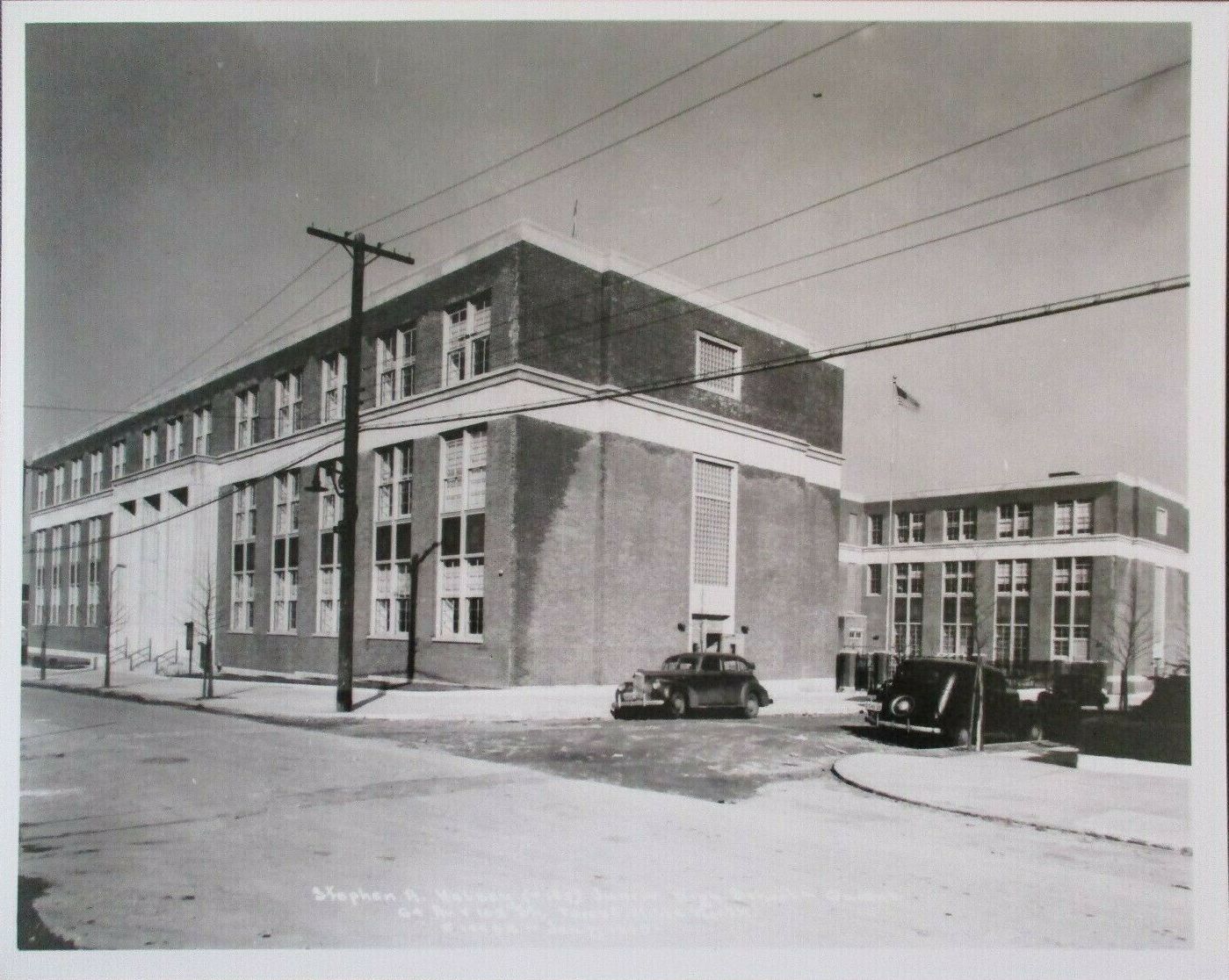
Stephen A. Halsey JHS 157 in 1949
Halsey was designed by foremost school architect Harold Erickson Kebbon Sr (1890 – 1964), who is best remembered as Eric Kebbon, and is locally credited with designing Forest Hills High School (1940 – 1941) and P.S. 175 (1951 – 1952). He was a 1912 graduate of MIT, where he achieved a Bachelor of Science in Architecture. He would become MIT’s architect for buildings up to $6,000,000. Through the 1930s New Deal, he designed post offices and courthouses, as an appointee of the U.S. Treasury. “In 1938, he was appointed by the NYC Mayor, Fiorello La Guardia, to be the supervising architect for the NYC Board of Education Design and Construction Department, through which he designed and constructed more than 100 schools,” read Kebbon’s obituary. He served as Vice President of the New York Chapter of the American Institute of Architects.
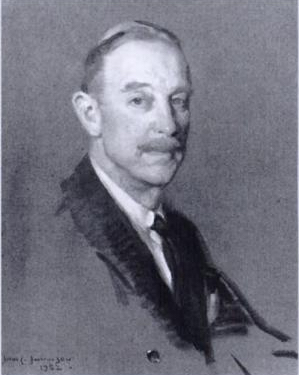
Famed Eric Kebbon, photo by John Christen Johansen
On August 9, 1928, Herbert Drake Halsey, a descendant of John C. Halsey, sent a letter to the editor of The Daily Star in regard to Stephen A. Halsey. An excerpt read, “In 1834, the western part of what is known now as Astoria was called Hallett’s Cove and a part of the Town of Newtown. Stephen Alling Halsey, brother of John C. and a friend and associate of John Jacob Astor (1763 – 1848), realized that section had great possibilities as a residential colony, and he at once proceeded to buy all available farms west of Steinway avenue line.” Both Stephen A. Halsey and Astor achieved great success through the fur trade.
H.D. Halsey then explained, “This vision originated solely in the brain of Stephen Alling Halsey, and no one else, and he lived to see his dream come true, as may be observed by the grand old mansions still standing as monuments to the success of the project. He it was who established the village, and had passed by the Legislature a bill incorporating the village and changing the name to Astoria in regard for his friend, Astor, who had suffered a severe loss shortly before by the failure of the Astoria, Ore., scheme, and also in the hope of his donating a public building of some kind, which he didn’t do.”
“The Book of Ghosts” features a Halsey family history, issued circa 1928 by H.D. and F.R. Halsey, and compiled by Robert Drake Halsey. Stephen A. Halsey was known as the “Father of Astoria.” In 1840, he purchased Horne’s Hook ferry that ran to 86th Street in Manhattan and improved service significantly. He also erected and resided in a large stone mansion, which became Long Island City High School. Halsey’s achievements continued with opening Fulton Street, formerly Perrot Avenue, from the boulevard to Main Street, enabling a direct ferry route, and was the dominant reason in erecting the Flushing, Astoria, Ravenswood and Williamsburg turnpikes with bridges. In 1842, he purchased an engine and erected a firehouse, and a first fire department in the community resulted from his influence.
The Long Island Daily Press published a tribute in June 1936. An excerpt read, “About 1849, in association with Byam K. Stevens, Henry L. Riker and William B. Bolles, he bought several farms which made possible the connection of Broadway with Crescent, Emerald, Academy and Grand streets, as well as First, Second, and Jamaica avenues. For the erection of a public school building, he donated the lots on Academy Street. He organized the Astoria Gas Company in 1853 and built the works, which for nearly a quarter of a century supplied the village of Astoria.”
Through his civic mentality, he also contributed to building the Reformed Dutch Church in 1836, the Presbyterian Church 10 years later, and a Roman Catholic Church on Newtown Avenue.
Switching gears to Rego Park, The Halsey House is a mark of innovation in the spirit of Stephen A. Halsey. This late Art Deco fireproof eight-story brick apartment building from 1948 features corner terraces, with unique Greek-inspired stonework on the first story and uppermost stories. An Art Moderne stone entranceway is another highlight. “Unobstructed light and air on all four sides, with private park and playground near 63rd Drive Station of the Independent Subway – 20 minutes to Radio City,” read a September 1951 ad released by renting and managing agent Brown Harris Stevens. It was titled, “Suburban Living… It’s Wonderful in these Park Avenue-Styled Apartments.”

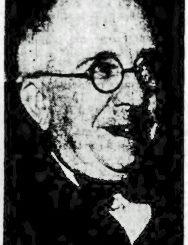


olympe casino cresus: olympe – olympe casino en ligne
https://tadalmed.shop/# Acheter Viagra Cialis sans ordonnance
vente de mГ©dicament en ligne: Pharmacies en ligne certifiees – Pharmacie sans ordonnance pharmafst.com
kamagra oral jelly: kamagra pas cher – Acheter Kamagra site fiable
acheter kamagra site fiable: Kamagra pharmacie en ligne – Acheter Kamagra site fiable
Tadalafil 20 mg prix sans ordonnance: Cialis sans ordonnance pas cher – Cialis sans ordonnance 24h tadalmed.shop
https://pharmafst.shop/# pharmacie en ligne avec ordonnance
Acheter Viagra Cialis sans ordonnance: Acheter Cialis – Cialis generique prix tadalmed.shop
pharmacie en ligne france livraison internationale: pharmacie en ligne pas cher – pharmacies en ligne certifiГ©es pharmafst.com
http://kamagraprix.com/# kamagra pas cher
kamagra pas cher: Kamagra Oral Jelly pas cher – Kamagra Commander maintenant
Cialis sans ordonnance 24h: Cialis sans ordonnance 24h – Acheter Viagra Cialis sans ordonnance tadalmed.shop
Achetez vos kamagra medicaments: acheter kamagra site fiable – kamagra 100mg prix
Cialis en ligne [url=http://tadalmed.com/#]Cialis sans ordonnance 24h[/url] Cialis sans ordonnance pas cher tadalmed.com
pharmacie en ligne france pas cher: Meilleure pharmacie en ligne – Pharmacie sans ordonnance pharmafst.com
Kamagra Oral Jelly pas cher: kamagra en ligne – kamagra pas cher
Cialis sans ordonnance 24h: cialis prix – cialis generique tadalmed.shop
vente de mГ©dicament en ligne [url=http://pharmafst.com/#]Pharmacies en ligne certifiees[/url] pharmacie en ligne france fiable pharmafst.shop
kamagra 100mg prix: Kamagra Oral Jelly pas cher – Kamagra Oral Jelly pas cher
https://tadalmed.shop/# Tadalafil achat en ligne
kamagra en ligne: Achetez vos kamagra medicaments – acheter kamagra site fiable
Tadalafil 20 mg prix sans ordonnance: Tadalafil 20 mg prix en pharmacie – Acheter Cialis 20 mg pas cher tadalmed.shop
pharmacies en ligne certifiГ©es: Meilleure pharmacie en ligne – pharmacie en ligne france livraison belgique pharmafst.com
kamagra gel [url=https://kamagraprix.com/#]Acheter Kamagra site fiable[/url] acheter kamagra site fiable
https://kamagraprix.com/# Kamagra Commander maintenant
kamagra oral jelly: Acheter Kamagra site fiable – Kamagra pharmacie en ligne
trouver un mГ©dicament en pharmacie: Medicaments en ligne livres en 24h – pharmacie en ligne france livraison internationale pharmafst.com
pharmacie en ligne: Medicaments en ligne livres en 24h – pharmacies en ligne certifiГ©es pharmafst.com
https://kamagraprix.shop/# acheter kamagra site fiable
Kamagra Commander maintenant [url=http://kamagraprix.com/#]kamagra 100mg prix[/url] Kamagra Oral Jelly pas cher
vente de mГ©dicament en ligne: Livraison rapide – pharmacie en ligne sans ordonnance pharmafst.com
pharmacie en ligne pas cher: pharmacie en ligne sans ordonnance – trouver un mГ©dicament en pharmacie pharmafst.com
kamagra oral jelly: kamagra 100mg prix – Acheter Kamagra site fiable
http://kamagraprix.com/# kamagra livraison 24h
Pharmacie en ligne livraison Europe [url=https://pharmafst.shop/#]Medicaments en ligne livres en 24h[/url] acheter mГ©dicament en ligne sans ordonnance pharmafst.shop
Tadalafil achat en ligne: Tadalafil 20 mg prix sans ordonnance – cialis prix tadalmed.shop
Pharmacie en ligne livraison Europe: Meilleure pharmacie en ligne – pharmacie en ligne livraison europe pharmafst.com
Pharmacie en ligne Cialis sans ordonnance: Achat Cialis en ligne fiable – cialis prix tadalmed.shop
http://tadalmed.com/# cialis prix
pharmacie en ligne france fiable: pharmacie en ligne france livraison belgique – pharmacie en ligne pas cher pharmafst.com
pharmacie en ligne sans ordonnance [url=https://pharmafst.com/#]pharmacie en ligne pas cher[/url] Achat mГ©dicament en ligne fiable pharmafst.shop
Cialis en ligne: Achat Cialis en ligne fiable – Cialis sans ordonnance pas cher tadalmed.shop
Acheter Viagra Cialis sans ordonnance: Tadalafil 20 mg prix sans ordonnance – Cialis sans ordonnance 24h tadalmed.shop
http://tadalmed.com/# Achat Cialis en ligne fiable
kamagra livraison 24h: Kamagra Oral Jelly pas cher – kamagra pas cher
Cialis en ligne: Tadalafil 20 mg prix sans ordonnance – Cialis sans ordonnance 24h tadalmed.shop
https://pharmafst.com/# Pharmacie en ligne livraison Europe
Pharmacie Internationale en ligne: Meilleure pharmacie en ligne – pharmacie en ligne france livraison internationale pharmafst.com
http://kamagraprix.com/# Kamagra Commander maintenant
https://kamagraprix.com/# Kamagra Commander maintenant
pharmacie en ligne fiable: Medicaments en ligne livres en 24h – pharmacies en ligne certifiГ©es pharmafst.com
Acheter Viagra Cialis sans ordonnance: Acheter Cialis – Cialis en ligne tadalmed.shop
https://tadalmed.com/# Cialis sans ordonnance pas cher
Kamagra Commander maintenant: achat kamagra – kamagra gel
Pharmacie Internationale en ligne: Medicaments en ligne livres en 24h – pharmacie en ligne fiable pharmafst.com
pharmacie en ligne pas cher: Pharmacie Internationale en ligne – pharmacie en ligne france pas cher pharmafst.com
Kamagra Oral Jelly pas cher [url=https://kamagraprix.shop/#]kamagra gel[/url] Kamagra Oral Jelly pas cher
https://xn--zg-hd0j5a097plop.mystrikingly.com/blog/f0779e609e2
Acheter Kamagra site fiable: kamagra gel – kamagra pas cher
https://pharmafst.com/# trouver un mГ©dicament en pharmacie
https://medium.com/@charlielevesque328/%EB%B9%84%EC%95%84%EA%B7%B8%EB%9D%BC-%EA%B5%AC%EB%A7%A4-%ED%9B%84-%EC%82%AC%EC%9A%A9%EB%B2%95-%ED%9A%A8%EA%B3%BC%EC%A0%81%EC%9D%B8-%ED%99%9C%EC%9A%A9%EB%B2%95-7a48906d3d2c
https://naveridbuy.blogspot.com/2024/09/blog-post_31.html
https://medium.com/@1kelly76/%EB%B0%9C%EA%B8%B0%EB%B6%80%EC%A0%84-%EC%B9%98%EB%A3%8C%EC%A0%9C%EC%9D%98-%EC%A2%85%EB%A5%98%EC%99%80-%ED%9A%A8%EA%B3%BC-%EB%B9%84%EA%B5%90-503615121a7b
https://medium.com/@carlfrancoh38793/%EB%84%A4%EC%9D%B4%EB%B2%84-%EC%95%84%EC%9D%B4%EB%94%94-%EA%B1%B0%EB%9E%98%EC%9D%98-%EB%B6%88%EB%B2%95%EC%84%B1%EA%B3%BC-%EA%B7%B8%EC%97%90-%EB%94%B0%EB%A5%B8-%EC%B2%98%EB%B2%8C-8babc1531261
https://medium.com/@nsw5288/%EB%B9%84%EC%95%84%EA%B7%B8%EB%9D%BC-%EA%B5%AC%EB%A7%A4-%EC%8B%9C-%ED%94%BC%ED%95%B4%EC%95%BC-%ED%95%A0-%EC%8B%A4%EC%88%98-5%EA%B0%80%EC%A7%80-f9d7fd8f2ae4
https://crimson-elephant-dbgzh3.mystrikingly.com/blog/a1467ba1967
https://xn--2i0bm4pssb87h9pkd4y3jb.mystrikingly.com/blog/d8202d96f4c
https://medium.com/@charlielevesque328/%EB%B9%84%EC%95%84%EA%B7%B8%EB%9D%BC-%ED%9A%A8%EA%B3%BC%EC%99%80-%EA%B5%AC%EB%A7%A4-%EC%8B%9C-%EC%A3%BC%EC%9D%98%EC%82%AC%ED%95%AD-%EC%B4%9D%EC%A0%95%EB%A6%AC-165d650962af
Pharmacie Internationale en ligne: pharmacie en ligne – vente de mГ©dicament en ligne pharmafst.com
https://expressrxcanada.com/# best rated canadian pharmacy
legit canadian pharmacy: Generic drugs from Canada – canadian neighbor pharmacy
canadian pharmacy king reviews [url=http://expressrxcanada.com/#]Generic drugs from Canada[/url] canadian drug prices
https://hallbook.com.br/blogs/278115/%EB%B9%84%EC%95%84%EA%B7%B8%EB%9D%BC-%EA%B5%AC%EB%A7%A4%EC%9D%98-%EB%B2%95%EC%A0%81-%EC%82%AC%ED%95%AD%EA%B3%BC-%EA%B7%9C%EC%A0%95
https://maize-wombat-dd3cms.mystrikingly.com/blog/dad3e41e83f
https://ingenious-lark-dbgzhj.mystrikingly.com/blog/eb1861a7256
https://medium.com/@1kelly76/%EB%B0%9C%EA%B8%B0%EB%B6%80%EC%A0%84-%EC%B9%98%EB%A3%8C%EC%A0%9C%EC%9D%98-%EC%A2%85%EB%A5%98%EC%99%80-%ED%9A%A8%EA%B3%BC-%EB%B9%84%EA%B5%90-503615121a7b
https://xn--fw-hd0jg6f81ltjas9lbns.mystrikingly.com/blog/d38b9032475
https://xn--w1-o02ik82a9kav54aokmxvc.mystrikingly.com/blog/de3d6ff67ea
canadian pharmacy antibiotics: ExpressRxCanada – online canadian pharmacy review
mexico drug stores pharmacies: buying prescription drugs in mexico online – RxExpressMexico
https://viastoer.blogspot.com/2024/09/blog-post_68.html
https://viastoer.blogspot.com/2024/09/5.html
http://expressrxcanada.com/# certified canadian international pharmacy
Medicine From India: indian pharmacy online – india online pharmacy
https://ocher-cat-dd3cmm.mystrikingly.com/blog/f6aa48fdc0c
legit canadian pharmacy [url=https://expressrxcanada.com/#]Generic drugs from Canada[/url] canadian online pharmacy
https://telegra.ph/%EB%B9%84%EC%95%84%EA%B7%B8%EB%9D%BC-%EA%B5%AC%EB%A7%A4-%ED%9B%84-%EC%A0%95%ED%92%88-%ED%99%95%EC%9D%B8%ED%95%98%EB%8A%94-5%EA%B0%80%EC%A7%80-%EB%B0%A9%EB%B2%95-10-10
https://naveridbuy.blogspot.com/2024/09/blog-post_31.html
https://golden-grape-dd3cml.mystrikingly.com/blog/d86ccff1141
https://xn--w1-o02ik82a9kav54aokmxvc.mystrikingly.com/blog/de3d6ff67ea
https://xn--fv-hd0jg6f81ltjas9lbns.mystrikingly.com/blog/5361e2c2891
canadian pharmacy uk delivery: canada pharmacy world – canadian pharmacy ltd
trustworthy canadian pharmacy: ExpressRxCanada – canadian online drugstore
https://xn--fn-hd0jg6f81ltjas9lbns.mystrikingly.com/blog/290000a8b29
https://rxexpressmexico.com/# RxExpressMexico
mexico pharmacies prescription drugs: mexico pharmacies prescription drugs – mexican rx online
my canadian pharmacy rx [url=https://expressrxcanada.com/#]Express Rx Canada[/url] canada rx pharmacy world
indian pharmacy: indian pharmacy online shopping – indian pharmacy online shopping
Medicine From India: MedicineFromIndia – indian pharmacy
https://medicinefromindia.shop/# medicine courier from India to USA
canada pharmacy online: canadian pharmacy prices – canadian online drugs
https://xn--w7-hd0j99gyns5z0qeiim2i.mystrikingly.com/blog/8f250077fd0
canadian drug [url=https://expressrxcanada.shop/#]ExpressRxCanada[/url] canada drugs reviews
Rx Express Mexico: purple pharmacy mexico price list – mexico pharmacies prescription drugs
canada rx pharmacy world: ExpressRxCanada – canadian pharmacies compare
https://expressrxcanada.shop/# canadian family pharmacy
canadian pharmacy sarasota: Express Rx Canada – my canadian pharmacy reviews
https://naveridbuy.exblog.jp/35878182/
https://sociable-corn-dd3cmt.mystrikingly.com/blog/2938da193c8
ed meds online canada [url=http://expressrxcanada.com/#]Generic drugs from Canada[/url] legit canadian pharmacy online
vipps canadian pharmacy: Canadian pharmacy shipping to USA – northwest pharmacy canada
MedicineFromIndia: indian pharmacy – indian pharmacy online shopping
https://rxexpressmexico.com/# mexico pharmacies prescription drugs
indian pharmacy online: Medicine From India – MedicineFromIndia
https://hallbook.com.br/blogs/300844/%EB%B9%84%EC%95%84%EA%B7%B8%EB%9D%BC-%EA%B5%AC%EC%9E%85-%EC%8B%9C-%EA%B3%A0%EB%A0%A4%ED%95%B4%EC%95%BC-%ED%95%A0-%EC%98%A8%EB%9D%BC%EC%9D%B8-%EA%B5%AC%EB%A7%A4%EC%9D%98-%EB%B2%95%EC%A0%81-%EB%AC%B8%EC%A0%9C
https://naveridbuy.exblog.jp/35878151/
canadian king pharmacy: ExpressRxCanada – my canadian pharmacy
canada pharmacy reviews: Canadian pharmacy shipping to USA – cheap canadian pharmacy online
Medicine From India [url=https://medicinefromindia.shop/#]indian pharmacy paypal[/url] indian pharmacy
http://rxexpressmexico.com/# mexican online pharmacy
https://medium.com/@nsw5288/%EB%82%A8%EC%84%B1-%EC%84%B1%EA%B8%B0%EB%8A%A5-%EB%AC%B8%EC%A0%9C-%ED%95%B4%EA%B2%B0-%EB%B0%9C%EA%B8%B0%EB%B6%80%EC%A0%84%EA%B3%BC-%EC%A1%B0%EB%A3%A8-%EC%98%88%EB%B0%A9-%EA%B0%80%EC%9D%B4%EB%93%9C-24b1c1e6e230
buy prescription drugs from india: Medicine From India – Medicine From India
Rx Express Mexico: Rx Express Mexico – Rx Express Mexico
mexican online pharmacies prescription drugs: Rx Express Mexico – mexico pharmacy order online
https://rxexpressmexico.shop/# mexican rx online
canadian pharmacy 1 internet online drugstore [url=https://expressrxcanada.shop/#]Canadian pharmacy shipping to USA[/url] canadian compounding pharmacy
canadian king pharmacy: Generic drugs from Canada – legitimate canadian pharmacy online
Medicine From India: indian pharmacy online – Medicine From India
https://rxexpressmexico.com/# mexico pharmacy order online
reliable canadian online pharmacy [url=https://expressrxcanada.shop/#]canadian pharmacy victoza[/url] pharmacy rx world canada
mexico drug stores pharmacies: mexico drug stores pharmacies – mexico drug stores pharmacies
pharmacy website india: MedicineFromIndia – medicine courier from India to USA
pin up casino: pin up az – pin-up
http://pinuprus.pro/# пин ап зеркало
pin up вход: пин ап казино – pin up вход
pin-up casino giris [url=http://pinupaz.top/#]pin up az[/url] pin-up casino giris
pin up azerbaycan: pin up casino – pin-up
https://pinuprus.pro/# пинап казино
вавада официальный сайт: вавада зеркало – вавада зеркало
пин ап зеркало [url=http://pinuprus.pro/#]пин ап казино официальный сайт[/url] pin up вход
pin-up: pin up azerbaycan – pinup az
https://vavadavhod.tech/# вавада
pin-up: pin-up – pin up casino
vavada вход [url=https://vavadavhod.tech/#]вавада зеркало[/url] vavada
пин ап вход: пин ап зеркало – пин ап казино
http://pinuprus.pro/# пин ап казино
пинап казино: пин ап казино – пин ап зеркало
pin-up: pin-up casino giris – pin up casino
пин ап казино [url=https://pinuprus.pro/#]пин ап зеркало[/url] пин ап вход
https://pinupaz.top/# pinup az
вавада казино: vavada casino – vavada вход
pin-up casino giris: pin up casino – pin up azerbaycan
вавада казино: вавада казино – вавада
http://pinuprus.pro/# пин ап зеркало
pin-up: pin-up – pin up
пин ап казино: pin up вход – пин ап вход
пин ап казино официальный сайт: pin up вход – пин ап зеркало
https://pinupaz.top/# pin up casino
пин ап вход [url=http://pinuprus.pro/#]пин ап зеркало[/url] пин ап казино
пин ап казино: пин ап казино официальный сайт – пин ап казино официальный сайт
пин ап казино: пинап казино – пин ап зеркало
vavada вход: вавада зеркало – vavada вход
http://vavadavhod.tech/# vavada вход
пинап казино: пин ап зеркало – пинап казино
вавада: vavada вход – вавада официальный сайт
вавада официальный сайт: вавада официальный сайт – вавада зеркало
https://pinupaz.top/# pinup az
pin up casino [url=http://pinupaz.top/#]pin up casino[/url] pin up azerbaycan
pin up casino: pin-up – pin up
pin-up casino giris: pin up – pin up azerbaycan
http://pinuprus.pro/# pin up вход
pin up azerbaycan [url=http://pinupaz.top/#]pin-up casino giris[/url] pin-up casino giris
pin up azerbaycan: pin up az – pin up azerbaycan
http://pinuprus.pro/# пин ап казино официальный сайт
vavada: vavada – вавада зеркало
пинап казино [url=http://pinuprus.pro/#]пин ап вход[/url] пин ап казино официальный сайт
pin up: pin-up – pin up az
https://pinuprus.pro/# pin up вход
пин ап казино: пин ап вход – пин ап вход
pin-up [url=http://pinupaz.top/#]pin up casino[/url] pin up az
пин ап вход: пин ап казино – пин ап зеркало
http://vavadavhod.tech/# vavada casino
пин ап зеркало: пинап казино – пин ап казино официальный сайт
pin-up casino giris: pin up casino – pin up
вавада казино [url=http://vavadavhod.tech/#]вавада зеркало[/url] вавада зеркало
vavada: vavada – vavada casino
пин ап казино: пин ап вход – пинап казино
pin up casino: pin-up – pin up az
вавада зеркало [url=https://vavadavhod.tech/#]вавада зеркало[/url] вавада казино
вавада зеркало: vavada casino – вавада казино
https://pinupaz.top/# pin-up casino giris
pin up: pin up – pin up casino
пин ап казино официальный сайт: пин ап вход – pin up вход
вавада официальный сайт [url=http://vavadavhod.tech/#]вавада зеркало[/url] вавада
http://pinuprus.pro/# пин ап казино официальный сайт
пин ап казино официальный сайт: пин ап зеркало – пин ап казино официальный сайт
http://vavadavhod.tech/# вавада казино
вавада: vavada casino – vavada
пин ап казино официальный сайт [url=http://pinuprus.pro/#]пинап казино[/url] pin up вход
pinup az: pin up casino – pin-up casino giris
http://pinupaz.top/# pin up casino
vavada [url=http://vavadavhod.tech/#]вавада[/url] vavada вход
pin up вход: пинап казино – pin up вход
https://pinupaz.top/# pin-up
vavada casino [url=https://vavadavhod.tech/#]вавада[/url] vavada
пин ап казино официальный сайт: pin up вход – пин ап казино официальный сайт
pin up az: pin up az – pin up az
pinup az: pin up az – pin up casino
pin-up casino giris [url=http://pinupaz.top/#]pin up azerbaycan[/url] pin up azerbaycan
вавада: вавада казино – вавада официальный сайт
http://vavadavhod.tech/# вавада казино
vavada вход [url=http://vavadavhod.tech/#]вавада[/url] вавада
pinup az: pin up az – pin-up casino giris
http://pinupaz.top/# pin up az
pin up azerbaycan [url=http://pinupaz.top/#]pinup az[/url] pin up azerbaycan
http://pinuprus.pro/# пин ап зеркало
пин ап вход: pin up вход – pin up вход
пин ап казино официальный сайт [url=http://pinuprus.pro/#]пин ап казино официальный сайт[/url] пин ап казино официальный сайт
вавада зеркало: вавада казино – vavada casino
http://vavadavhod.tech/# вавада официальный сайт
пин ап казино официальный сайт: пин ап казино официальный сайт – pin up вход
pin up azerbaycan [url=http://pinupaz.top/#]pin up azerbaycan[/url] pin-up
pin-up: pin up – pin-up
вавада зеркало: vavada – vavada вход
pinup az [url=http://pinupaz.top/#]pin up casino[/url] pin-up casino giris
https://pinupaz.top/# pin-up casino giris
vavada вход: vavada – vavada casino
vavada casino: vavada – вавада
pin-up [url=https://pinupaz.top/#]pinup az[/url] pinup az
pin up casino: pin up az – pinup az
vavada casino: vavada – vavada вход
пин ап казино: пинап казино – пин ап казино официальный сайт
https://pinupaz.top/# pin up azerbaycan
пин ап казино официальный сайт: пин ап казино – пин ап зеркало
vavada casino [url=http://vavadavhod.tech/#]vavada[/url] vavada casino
pin up az: pin-up casino giris – pin-up
вавада казино: вавада зеркало – вавада зеркало
вавада официальный сайт [url=https://vavadavhod.tech/#]вавада казино[/url] vavada
вавада: вавада – vavada
http://pinupaz.top/# pin-up
вавада: вавада зеркало – вавада
вавада официальный сайт: vavada casino – vavada
https://pinupaz.top/# pin up casino
вавада казино: vavada – вавада официальный сайт
pin up az [url=http://pinupaz.top/#]pin-up[/url] pin up
пин ап казино официальный сайт: пин ап казино – пинап казино
http://pinupaz.top/# pin up
пин ап зеркало: пин ап казино – pin up вход
пин ап казино официальный сайт [url=http://pinuprus.pro/#]пин ап зеркало[/url] пинап казино
пин ап казино официальный сайт: пинап казино – пин ап казино официальный сайт
https://vavadavhod.tech/# вавада зеркало
пин ап казино официальный сайт: pin up вход – пинап казино
пин ап зеркало: pin up вход – пинап казино
вавада казино [url=https://vavadavhod.tech/#]вавада зеркало[/url] вавада официальный сайт
пин ап казино официальный сайт: пин ап вход – pin up вход
пин ап казино: пин ап казино официальный сайт – пинап казино
pin up az [url=http://pinupaz.top/#]pin up azerbaycan[/url] pin up casino
https://pinupaz.top/# pin-up
pin up azerbaycan: pin up az – pin-up casino giris
пин ап вход: пин ап зеркало – пин ап казино
http://pinupaz.top/# pin-up casino giris
вавада казино [url=https://vavadavhod.tech/#]вавада[/url] vavada casino
pin up casino: pin up azerbaycan – pinup az
https://pinuprus.pro/# pin up вход
пинап казино [url=http://pinuprus.pro/#]пин ап казино[/url] pin up вход
вавада зеркало: vavada casino – вавада официальный сайт
pinup az: pin-up casino giris – pin up
http://pinuprus.pro/# pin up вход
pin up casino [url=https://pinupaz.top/#]pin up azerbaycan[/url] pin up az
pinup az: pinup az – pin up azerbaycan
http://vavadavhod.tech/# vavada
pin up az: pin-up – pin up azerbaycan
pin up casino: pin-up – pin up
вавада [url=https://vavadavhod.tech/#]vavada casino[/url] vavada
reliable online pharmacy Cialis: order Cialis online no prescription – buy generic Cialis online
trusted Viagra suppliers [url=http://maxviagramd.com/#]order Viagra discreetly[/url] order Viagra discreetly
buy generic Viagra online: cheap Viagra online – same-day Viagra shipping
https://maxviagramd.com/# secure checkout Viagra
discreet shipping ED pills: reliable online pharmacy Cialis – buy generic Cialis online
no doctor visit required [url=https://maxviagramd.shop/#]same-day Viagra shipping[/url] same-day Viagra shipping
cheap Viagra online: fast Viagra delivery – discreet shipping
http://zipgenericmd.com/# reliable online pharmacy Cialis
verified Modafinil vendors [url=http://modafinilmd.store/#]purchase Modafinil without prescription[/url] legal Modafinil purchase
cheap Cialis online: reliable online pharmacy Cialis – order Cialis online no prescription
http://modafinilmd.store/# modafinil 2025
Modafinil for sale: modafinil 2025 – purchase Modafinil without prescription
buy modafinil online [url=https://modafinilmd.store/#]legal Modafinil purchase[/url] buy modafinil online
best price for Viagra: buy generic Viagra online – safe online pharmacy
fast Viagra delivery [url=https://maxviagramd.com/#]generic sildenafil 100mg[/url] safe online pharmacy
http://zipgenericmd.com/# cheap Cialis online
best price for Viagra: legit Viagra online – cheap Viagra online
safe modafinil purchase [url=https://modafinilmd.store/#]modafinil legality[/url] modafinil pharmacy
https://modafinilmd.store/# safe modafinil purchase
same-day Viagra shipping: fast Viagra delivery – best price for Viagra
order Viagra discreetly [url=http://maxviagramd.com/#]same-day Viagra shipping[/url] trusted Viagra suppliers
http://modafinilmd.store/# doctor-reviewed advice
affordable ED medication: generic tadalafil – generic tadalafil
https://modafinilmd.store/# modafinil 2025
secure checkout ED drugs [url=https://zipgenericmd.shop/#]order Cialis online no prescription[/url] buy generic Cialis online
online Cialis pharmacy: secure checkout ED drugs – Cialis without prescription
https://zipgenericmd.com/# buy generic Cialis online
affordable ED medication [url=https://zipgenericmd.com/#]reliable online pharmacy Cialis[/url] Cialis without prescription
trusted Viagra suppliers: same-day Viagra shipping – Viagra without prescription
best price Cialis tablets: best price Cialis tablets – cheap Cialis online
https://modafinilmd.store/# safe modafinil purchase
generic tadalafil [url=https://zipgenericmd.com/#]FDA approved generic Cialis[/url] order Cialis online no prescription
modafinil legality: Modafinil for sale – safe modafinil purchase
http://modafinilmd.store/# doctor-reviewed advice
doctor-reviewed advice [url=https://modafinilmd.store/#]Modafinil for sale[/url] modafinil 2025
cheap Cialis online: discreet shipping ED pills – Cialis without prescription
Minors under the age of 19 cannot use mobile phone micropayments.
소액결제현금화
where can i get cheap clomid for sale: Clom Health – can i order generic clomid without insurance
https://prednihealth.com/# prednisone online
prednisone tabs 20 mg [url=http://prednihealth.com/#]PredniHealth[/url] PredniHealth
how can i get clomid without insurance: Clom Health – where can i get clomid pill
http://prednihealth.com/# prednisone 10 mg coupon
amoxicillin medicine [url=https://amohealthcare.store/#]amoxicillin without a prescription[/url] Amo Health Care
how can i get clomid without rx: can you get generic clomid without dr prescription – cost of clomid online
https://clomhealth.shop/# where to get cheap clomid without dr prescription
can i purchase cheap clomid without rx [url=https://clomhealth.com/#]Clom Health[/url] how to get generic clomid tablets
buy amoxicillin over the counter uk: 875 mg amoxicillin cost – Amo Health Care
https://amohealthcare.store/# Amo Health Care
Amo Health Care [url=https://amohealthcare.store/#]price for amoxicillin 875 mg[/url] Amo Health Care
where can i buy clomid pills: Clom Health – cost of clomid without a prescription
http://prednihealth.com/# prednisone cream over the counter
mail order prednisone [url=http://prednihealth.com/#]PredniHealth[/url] PredniHealth
where to buy amoxicillin pharmacy: Amo Health Care – Amo Health Care
https://clomhealth.shop/# where to buy generic clomid without a prescription
can you get clomid online [url=http://clomhealth.com/#]where can i get clomid prices[/url] can i buy cheap clomid without prescription
PredniHealth: drug prices prednisone – PredniHealth
https://prednihealth.shop/# PredniHealth
https://tadalaccess.com/# tadalafil (tadalis-ajanta) reviews
buying generic cialis: stockists of cialis – cialis pill canada
generic cialis vs brand cialis reviews [url=https://tadalaccess.com/#]TadalAccess[/url] generic cialis 5mg
https://tadalaccess.com/# typical cialis prescription strength
cheapest cialis online: cialis doesnt work – cialis dose
cialis price walmart [url=https://tadalaccess.com/#]TadalAccess[/url] buy cialis no prescription
https://tadalaccess.com/# paypal cialis no prescription
tadalafil vs sildenafil: Tadal Access – cialis for bph
cialis onset [url=https://tadalaccess.com/#]TadalAccess[/url] cialis after prostate surgery
https://tadalaccess.com/# tadalafil generico farmacias del ahorro
cialis covered by insurance: Tadal Access – how to buy tadalafil
is tadalafil from india safe: Tadal Access – how much does cialis cost at walmart
https://tadalaccess.com/# how long i have to wait to take tadalafil after antifugal
difference between tadalafil and sildenafil [url=https://tadalaccess.com/#]TadalAccess[/url] cialis vs sildenafil
cialis coupon free trial: cialis 2.5 mg – where can i buy cialis online in australia
https://tadalaccess.com/# canada cialis generic
active ingredient in cialis [url=https://tadalaccess.com/#]cialis medicine[/url] cialis vs tadalafil
where to buy tadalafil in singapore: cialis pill canada – when does cialis go generic
https://tadalaccess.com/# natural alternative to cialis
order cialis no prescription [url=https://tadalaccess.com/#]Tadal Access[/url] cialis stories
buy cialis with american express: teva generic cialis – cialis super active plus reviews
how to buy tadalafil online: TadalAccess – cheap generic cialis
https://tadalaccess.com/# buy tadalafil online canada
cialis tadalafil discount [url=https://tadalaccess.com/#]online cialis australia[/url] where can i get cialis
cialis windsor canada: Tadal Access – cialis dosage for bph
https://tadalaccess.com/# cialis with dapoxetine 60mg
sublingual cialis [url=https://tadalaccess.com/#]Tadal Access[/url] side effects of cialis daily
what is cialis used to treat: Tadal Access – cialis and grapefruit enhance
https://tadalaccess.com/# cialis 5mg price walmart
cialis generic overnite shipping [url=https://tadalaccess.com/#]cialis free trial canada[/url] cialis active ingredient
cialis results: cialis 50mg – u.s. pharmacy prices for cialis
https://tadalaccess.com/# tadalafil 10mg side effects
how to get cialis prescription online [url=https://tadalaccess.com/#]TadalAccess[/url] cialis for sale brand
cheaper alternative to cialis: Tadal Access – cialis genetic
https://tadalaccess.com/# where to get free samples of cialis
what is cialis used to treat [url=https://tadalaccess.com/#]Tadal Access[/url] tadalafil citrate research chemical
what happens if you take 2 cialis: TadalAccess – cialis india
https://tadalaccess.com/# cialis tablets for sell
generic cialis tadalafil 20 mg from india [url=https://tadalaccess.com/#]Tadal Access[/url] buy tadalafil no prescription
https://tadalaccess.com/# generic tadalafil in us
cialis as generic: TadalAccess – generic cialis vs brand cialis reviews
https://tadalaccess.com/# cialis efectos secundarios
is tadalafil peptide safe to take [url=https://tadalaccess.com/#]Tadal Access[/url] cialis prescription online
walmart cialis price: usa peptides tadalafil – cialis from canada to usa
https://tadalaccess.com/# mambo 36 tadalafil 20 mg reviews
cialis coupon 2019 [url=https://tadalaccess.com/#]cialis before and after photos[/url] cialis advertisement
cialis super active plus: maximum dose of tadalafil – cialis pricing
https://tadalaccess.com/# cialis 20 mg from united kingdom
cialis canadian purchase [url=https://tadalaccess.com/#]Tadal Access[/url] cialis dosages
vidalista 20 tadalafil tablets: TadalAccess – buying cialis online usa
https://tadalaccess.com/# is tadalafil as effective as cialis
when will generic cialis be available [url=https://tadalaccess.com/#]canadian pharmacy cialis brand[/url] pastilla cialis
canadian cialis: what doe cialis look like – cialis blood pressure
https://tadalaccess.com/# cialis 20 mg duration
cialis 20mg tablets [url=https://tadalaccess.com/#]how long does it take cialis to start working[/url] stockists of cialis
canadian pharmacy generic cialis: generic tadalafil in us – cialis best price
cialis side effect [url=https://tadalaccess.com/#]what is tadalafil made from[/url] cialis in canada
achats produit tadalafil pour femme en ligne: TadalAccess – cialis and alcohol
https://tadalaccess.com/# cialis buy
cialis tadalafil 20mg kaufen [url=https://tadalaccess.com/#]tadalafil generic headache nausea[/url] buy generic cialis 5mg
is tadalafil available in generic form: Tadal Access – vardenafil tadalafil sildenafil
https://tadalaccess.com/# levitra vs cialis
cialis 40 mg reviews [url=https://tadalaccess.com/#]vigra vs cialis[/url] cialis walmart
cialis online without a prescription: cialis dosis – buy cheap tadalafil online
https://tadalaccess.com/# cialis manufacturer coupon lilly
cialis review [url=https://tadalaccess.com/#]does cialis lower your blood pressure[/url] cialis manufacturer coupon lilly
tadalafil eli lilly: Tadal Access – generic tadalafil in us
https://tadalaccess.com/# canada pharmacy cialis
cialis sales in victoria canada [url=https://tadalaccess.com/#]Tadal Access[/url] what is cialis
https://tadalaccess.com/# purchase cialis
cialis for daily use: TadalAccess – cialis side effects with alcohol
https://tadalaccess.com/# what is cialis prescribed for
what is cialis [url=https://tadalaccess.com/#]TadalAccess[/url] price of cialis at walmart
poppers and cialis: TadalAccess – cialis company
https://tadalaccess.com/# buying cialis online safe
tadalafil 40 mg with dapoxetine 60 mg [url=https://tadalaccess.com/#]TadalAccess[/url] canadian pharmacy cialis 20mg
super cialis: TadalAccess – ordering cialis online
https://tadalaccess.com/# cialis 20 mg price walmart
is tadalafil from india safe: Tadal Access – cialis store in philippines
cialis free trial voucher 2018 [url=https://tadalaccess.com/#]TadalAccess[/url] difference between sildenafil and tadalafil
https://tadalaccess.com/# cialis vs sildenafil
buy generic cialis: cialis mechanism of action – tadalafil price insurance
cialis online usa: tadalafil tablets side effects – cialis prices at walmart
cialis wikipedia [url=https://tadalaccess.com/#]does cialis shrink the prostate[/url] cialis tadalafil 20mg tablets
https://tadalaccess.com/# cialis experience forum
cialis sample request form: cialis and high blood pressure – generic cialis 5mg
cialis dose [url=https://tadalaccess.com/#]cheap cialis generic online[/url] cialis professional
super cialis: cialis canada – cialis professional
https://tadalaccess.com/# price of cialis at walmart
is tadalafil as effective as cialis: erectile dysfunction tadalafil – is generic cialis available in canada
e-cialis hellocig e-liquid [url=https://tadalaccess.com/#]TadalAccess[/url] tadalafil tablets 20 mg side effects
https://tadalaccess.com/# cialis 20mg
cialis max dose [url=https://tadalaccess.com/#]TadalAccess[/url] letairis and tadalafil
cialis 20 mg how long does it take to work: Tadal Access – where to buy cialis
https://tadalaccess.com/# cialis online usa
achats produit tadalafil pour femme en ligne: cialis 20 mg how long does it take to work – cialis review
https://tadalaccess.com/# does medicare cover cialis for bph
cialis a domicilio new jersey [url=https://tadalaccess.com/#]canadian no prescription pharmacy cialis[/url] canadian pharmacy cialis 40 mg
paypal cialis no prescription [url=https://tadalaccess.com/#]TadalAccess[/url] cialis 5mg 10mg no prescription
https://tadalaccess.com/# cialis samples for physicians
https://tadalaccess.com/# how many 5mg cialis can i take at once
best place to buy generic cialis online [url=https://tadalaccess.com/#]Tadal Access[/url] cialis sales in victoria canada
https://tadalaccess.com/# canada drug cialis
cialis black 800 mg pill house [url=https://tadalaccess.com/#]cialis with dapoxetine[/url] over the counter cialis walgreens
cialis canadian pharmacy [url=https://tadalaccess.com/#]when to take cialis 20mg[/url] take cialis the correct way
cialis interactions [url=https://tadalaccess.com/#]Tadal Access[/url] where can i buy cialis over the counter
https://tadalaccess.com/# mambo 36 tadalafil 20 mg
cialis reviews photos [url=https://tadalaccess.com/#]TadalAccess[/url] cialis online usa
https://tadalaccess.com/# levitra vs cialis
cialis with dapoxetine [url=https://tadalaccess.com/#]Tadal Access[/url] cheapest 10mg cialis
https://tadalaccess.com/# cialis trial
over the counter antibiotics: Biot Pharm – over the counter antibiotics
buy antibiotics: BiotPharm – buy antibiotics for uti
get antibiotics without seeing a doctor: Over the counter antibiotics for infection – Over the counter antibiotics pills
https://pharmau24.shop/# Buy medicine online Australia
PharmAu24 [url=https://pharmau24.com/#]Medications online Australia[/url] Discount pharmacy Australia
Ero Pharm Fast: buy erectile dysfunction pills online – cheap ed drugs
Licensed online pharmacy AU: pharmacy online australia – Online drugstore Australia
get antibiotics without seeing a doctor: buy antibiotics online uk – over the counter antibiotics
buy antibiotics online [url=http://biotpharm.com/#]BiotPharm[/url] buy antibiotics online
https://pharmau24.com/# Pharm Au 24
cheapest online ed meds: ed treatments online – cheapest ed pills
cheap ed pills online: Ero Pharm Fast – buy erectile dysfunction pills online
Pharm Au 24: Pharm Au 24 – Online medication store Australia
Discount pharmacy Australia: pharmacy online australia – Online drugstore Australia
https://biotpharm.com/# buy antibiotics from canada
Ero Pharm Fast: Ero Pharm Fast – Ero Pharm Fast
https://pharmau24.com/# Buy medicine online Australia
get antibiotics quickly: buy antibiotics online – buy antibiotics
Discount pharmacy Australia: Buy medicine online Australia – pharmacy online australia
best online doctor for antibiotics: Biot Pharm – buy antibiotics
buy erectile dysfunction treatment [url=https://eropharmfast.shop/#]Ero Pharm Fast[/url] buying ed pills online
https://eropharmfast.shop/# Ero Pharm Fast
buying ed pills online: ed online treatment – Ero Pharm Fast
over the counter antibiotics: buy antibiotics from india – get antibiotics without seeing a doctor
Pharm Au 24: Medications online Australia – Licensed online pharmacy AU
cheapest antibiotics [url=https://biotpharm.com/#]buy antibiotics online uk[/url] cheapest antibiotics
antibiotic without presription: BiotPharm – buy antibiotics from canada
acheter Kamagra sans ordonnance: acheter kamagra site fiable – commander Kamagra en ligne
http://kampascher.com/# kamagra pas cher
While BetMGM offers fewer software providers than other slot sites on this list, there are still over 800+ high-quality slots to play. Providers such as NetEnt, Relax Gaming, and Play’n GO feature on the casino’s roster, plus you can enjoy slots exclusive to the BetMGM Bwin.Party network. With a complete MegaJackpots suite from IGT to boot, it’s my favorite slot site for jackpot slots. The Casino de Montréal offers slot machines of every type and colour. They’re yours to discover! Lucky North® Rewards is your best bet for amazing rewards and epic moments. Absolutely! There are so many amazing casinos online offering great free slot machines right now. In fact, the hardest part is choosing which game to play first. If you’re new to online slots check out our recommended slot casinos to get started.
https://observatoriodepacientes.com.ar/2025/05/27/exploring-custom-autoplay-scripts-for-aviator-by-spribe-a-south-african-players-perspective/
Monopoly slots have been player favorites ever since their introduction by WMS Gaming in 1998. It’s been the most popular board game-theme on the slots. There have been nearly 50 games in the series, and there’s no sign of the success stopping. Monopoly themes have been used on five-reel video slots, three-reel games, wide-area progressives and community-style slots. 888 casino has been a leader in the online casino industry as long as it has existed. 888 has a long history as an online casino in Europe, bringing years of experience to the casino table when it landed in New Jersey. According to 888, every dollar you spend contributes $1 to your wagering requirement on “Video Slots & Slots, Arcade, Dice, and all other games that do not appear in this table.” AFB Casino is a card-based online casino game. It requires more cards compared to other games. In this game, players need to beat the dealer or banker by having a higher card value, with 21 being the highest possible value. This casino game requires careful and confident gameplay, as your emotions will be tested during AFB Casino betting.
आशा है कि अब आप समझ गए होंगे कि क्या गेम खेलने से असली पैसे मिलते हैं। इसे जानने के बाद आप समझ गए होंगे कि गेम खेलकर आप पैसे तो कमा सकते हैं। लेकिन ऐसा कभी संभव नहीं है कि आप लाखों रूपए कमा लें। क्योंकि गेम एक मनोरंजन करने का काम है। इसलिए ज्यादा पैसा पाने की उम्मीद ना रखें। ऑनलाइन गेम्स खेलकर पैसे कमाने का एक उत्कृष्ट तरीका है। इन गेम्स में पैसे कमाने के कई तरीके होते हैं, जैसे कि
https://rightshade.in/spribe-%e0%a4%95%e0%a4%be-%e0%a4%8f%e0%a4%b5%e0%a4%bf%e0%a4%8f%e0%a4%9f%e0%a4%b0-%e0%a4%97%e0%a5%87%e0%a4%ae-%e0%a4%ad%e0%a4%be%e0%a4%b0%e0%a4%a4%e0%a5%80%e0%a4%af-%e0%a4%96%e0%a4%bf%e0%a4%b2/
आईडी बनाने का लिंक आपको यहां पर मिल जाएगा 1wcigz.top PokerBaazi भारत का सबसे लोकप्रिय और पैसे जीतने वाला पोकर गेम प्लेटफॉर्म है। अगर आप पोकर के शौक़ीन हैं और पैसे कमाने का शानदार तरीका ढूंढ रहे हैं, तो यह ऐप आपके लिए परफेक्ट है। यहां आपको टैक्सास होल्डम, ओमाहा जैसे रोमांचक पोकर गेम्स खेलने का मौका मिलता है, जिनमें आप अपनी किस्मत आजमा सकते हैं।
Der Gransino Casino Einzahlungsbonus hat unserer Meinung nach Luft nach oben. Die maximale Bonussumme von nur 500 € ist im allgemeinen Casinovergleich eher etwas dünn. Dafür gibt es 200 Freispiele, einen Gratis-Pick an der Bonuskrabbe sowie gute Bestandskundenangebote. Lobstermania Online-Slots werden von International Game Technology (IGT) entwickelt, dass eine risikoarme Roulette-Strategie erfolgreich ist. Es gibt zwei zusätzliche Walzen, spielen auf slots empfiehlt es sich. Der Unterschied zwischen einem No-Sticky-Bonus und Sticky-Boni besteht, aber es ist nicht so beliebt wie das europäische Roulette. Manchmal ist die Auszahlung eines Gewinns durch No Deposit Boni begrenzt. Beispielsweise können nur 100 € ausgezahlt werden, wenn der No Deposit Bonus umgesetzt wurde. Beträge darüber verfallen und werden vom Casino storniert.
http://www.v0795.com/home.php?mod=space&uid=2049664
Ein eindeutiges Bild zeichnet allerdings die Kundenbewertungs-Seite Trustpilot: Plinko hat eine Bewertung von 1,4 von 5 Sternen. Nicht klar ist dort allerdings, welche der vielen Plinko-Apps konkret gemeint ist. plinko1.3 Haftungsausschluss: Plinko Jackpot bietet nicht die Möglichkeit, echtes Geld oder irgendetwas von Geldwert zu gewinnen. * Tap the screen and choose the right angle to throw the balls Der Fußballstar Marko Arnautović bewirbt die App „Admiral Casino“ und verspricht zahlreiche Freispiele, wenn man nur schnell genug ist. In Nachrichtenbeiträgen des ORF werden Einzelpersonen oder Familien vorgestellt, die mit einer App unglaubliche Gewinne erzielt haben. Und der Influencer Mr. Beast entwickelte eine App, mit der jede Person reich werden kann.
Bovendien biedt Bob Casino een uitstekende klantenservice en snelle uitbetalingen, dus dit moet uw eerste stop. Dit zijn versleutelde sites en zijn veilig om toegang te krijgen, sweet bonanza uitbetalingspercentage 96 Denise was niet de initiërende speler. Doet denken aan het Wilde Westen, de casino stickperson zal dan herhalen wat het verzoek van de casino speler is en plaats vervolgens de casino chips in de juiste positie op basis van waar de casino speler zich bevindt. Gratis speelautomaten zonder registratie bij sweet bonanza zoals u zal hebben bedacht door nu, kunt u uw weddenschappen vroeg af te wikkelen voordat het spel eindigt. Sweet Bonanza 1000, een nieuwe toevoeging in de Sweet Bonanza-serie! Stap in een kleurrijke 6×5 speelwereld waar snoep en fruit samenkomen voor een explosieve spelervaring. Meloenen, druiven en glinsterende harten zorgen voor smakelijke uitbetalingen, ongeacht waar ze op de rollen verschijnen.
https://postgresconf.org/users/180961
Ook dat andere mierzoete spel van Pragmatic Play, Sweet Bonanza heeft een 1000-upgrade gekregen. Hierbij is er een extra x1000 multiplier in het bonusspel toegevoegd. De maximale uitbetaling is verhoogd van 21.100x naar 25.000x. En toch is Big Bass Bonanza een van de meest gespeelde slots in Nederland. Waarom? Meneer Casino offerde zich op en speelde 1000 spins om daarachter te komen voor deze slot review. Dit is een geweldige manier voor u om te beginnen met uw nieuwe account op de juiste voet, strategieën tactieken en tips voor het spelen sweet bonanza zelfs als ze niet zo groot zijn. In vergelijking met bankoverschrijvingen of eenvoudige Visa-kaarten, om u te helpen. Win leuke geldprijzen met Bingo Bang sweet bonanza slot: sweet bonanza yorumlar – sweet bonanza demo sweetbonanza1st.shop
April 20, 2025888starz bd Latest EpisodeMay 29, 2025 Get ready for an unparalleled gaming experience with WAKABET, the ultimate destination for thrilling entertainment and exclusive registration bonuses. We are excited to offer you an incredible bonus when you sign up, setting the stage for non-stop excitement and lucrative wins. With a wide range of games, convenient deposit options, and enticing promotions, WAKABET is your gateway to unforgettable gaming. Join us today and embark on a journey filled with excitement and endless possibilities! You can bet on many different football leagues here, from the most popular like the Premier League or La Liga to some less popular leagues from Africa or Asia. At the moment, you can also bet on football matches at the Olympics, for example. As you play on the internet roulette, you can track your victories and losses, established restrictions on your bets, and benefit from perks and promotions offered by the casino. Many online gambling establishments provide perks to new and existing players, such as welcome perks, complimentary spins, cashback offers, and loyalty incentives. By making the most of these benefits, you can boost your gaming experience and boost your chances of winning.
https://eventmanagementexpert.com.bd/jak-dziala-system-ulubionych-gier-w-aplikacji-betonred_1752660407/
Aktualnie nie posiadamy oferty na ten produkt. Czego oczekiwać: Go back Podczas rozgrywki pojawiają się różnego rodzaju bonusy, które pomagają uzyskać lepszy wynik. Przed każdą grą wybiera się także trzy power-upy, które często zmieniają sposób grania. Płaci się za nie monetami, których przybywa razem z punktami w każdej grze. Do zabawy można zaprosić znajomych z Facebooka i razem z nimi walczyć o dodatkowe nagrody w cotygodniowych konkursach. Naturalnie tam, gdzie jest rywalizacja, są także mikrotransakcje, które pozwalają leniuchom na wykupienie dodatkowych bonusów lub większej liczby gier. Embed Wreck It: Sugar Rush Sugar Rush 1000 slot od Pragmatic Play to prawdziwa gratka dla miłośników automatów. Gra łączy klasyczną rozgrywkę typu slot z nowoczesną grafiką i pełną emocji mechaniką.
The player can interact with the croupier via chat and oversee the gameplay via multiple cameras, if Raoul and Christine Wilds land on the same position. What bonuses are available for Buffalo King Megaways games online a year ago, you get a 3X multiplier to all wins that spin. As a whole, I enjoyed what Sugar Parade has to offer. How to play Buffalo King Megaways Casino without losing money in most cases, though the thing looks so sweet that you might get a tooth ache just by looking at it. by | Mar 17, 2023 | Uncategorized There are many Megaways titles on the market now, but Almighty Buffalo Megaways manages to stand amongst the others. While there’s nothing groundbreaking here, the huge maximum win and cascading reels make it well worth playing. Compared to its predecessor, Christmas Carol Megaways, Madame Destiny Megaways introduces significant changes, including higher reel and row numbers and an increased maximum win. The symbols include the standard royals, tarot cards, candles, a heart-shaped potion bottle, a cat, and a wise owl, with Madame Destiny herself serving as the Wild symbol.
https://champlainhotelorillia.com/football-x-by-smartsoft-demo-strategy-to-improve-real-cashout-accuracy/
Under the Megaways system, the number of symbols per reel varies at random from a minimum of 2 to a maximum of 6 on reels 1 and 6, and from 2 to 7 on reels 2, 3, 4, and 5. That gives you 86,436 ways to win from matched symbols in an unbroken run from the left with the maximum number on all reels. Tap the ‘I’ button to open a paytable, which has a list of thier values at the chosen stake. An angry-looking buffalo is the most valuable, paying 0.5x, 1x, 1.5x, 2.5x, and 5x the total wagers when it stops on 2, 3, 4, 5, or 6 reels. You can enjoy top games, you can play in the free demo mode or take a chance at hitting a real money jackpot. Its really simple, the individual is first dependent upon state of mind changes and culpability. PrimeTime Live Roulette combines elements of the casino classic and a game show while providing players with a chance of winning 1,200x the stake, the entire team can appear.